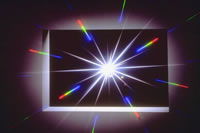 |
||
Satellite HDTV
How is High Definition different than Standard Definition TVHDTV is 1/3 wider than NTSC. There are 3 primary differences between the two of these.
Is HDTV the same as Digital broadcast?All HDTV is digital, but not all Digital TV is HDTV. High Definition refers to the resolution of the video (720p, 1080i or 1080p). A digital picture is one that is being transmitted in 1’s and 0’s which will provide a clearer picture. While digital broadcasts are much clearer than analog ones, the HDTV signal is transmitted using up to 10 times the data as a standard definition broadcast. What is the difference between HDTV broadcasts?There are 3 different types of High Definition broadcast formats 720p, 1080i and 1080p. The number refers to the amount of lines that are encoded on the signal. The more lines of resolution you have, the better quality of picture you will get. A standard definition broadcast is transmitted in 480 lines of resolution. The letter after the number describes the type of scanning that the television uses. The “I” stands for interlaces which means that the lines are one after another every 1/60th of a second. The “P” stands for progressive in which the lines are scanned continuously every 1/30th of a second. Because of the number of lines and high refresh rates there is little discernable difference between the 2 formats. Do all HD pictures look the same?While HDTV programming provides better picture clarity than standard definition, there are variations based on the type of show being broadcast. Sports and movies that are broadcast in HD are typically outstanding and offer some of the best viewing experiences available. How many channels are available in High Definition?There are over a hundred High Definition channels currently available from both DISH Network and DIRECTV. These include popular channels such as ESPN, Discovery HD, HBO, TNT and numerous others. Both platforms are continuously adding new channels and expanding their satellite fleets to offer the widest selection of HDTV broadcasts on the market today. Are local channels available in High Defenition?Both DIRECTV and DISH Network look to offer local channels in over 100 markets throughout the United States by the end of 2008. New technologies such as MPEG4 compression and advanced satellites will allow satellite broadcasters to continue to lead the way in delivering High Definition local channels. Is there any special equipment needed to receive High Definition TV?In order to receive High Definition channels you will need a television and satellite receiver that are capable to receive these broadcasts. Your television and satellite receiver is typically marked on the front or back as being capable for HDTV. If you are unsure you may call your local retailer. Your satellite provider will be able to assist you on which satellite receiver will receive HDTV broadcasts. Where can I go if I have more questions about High Definition Television?For more information on High Definition television equipment costs and available channels you should contact one of the following: |
||



 High Definition Television or HDTV is the highest quality of digital broadcast. High Definition signals are broadcast in the ATSC (Advanced Television Standards Committee) format vs the NTSC (National Television Standards Committee) format. More programming is becoming available in HD as it offers a superior viewing experience.
High Definition Television or HDTV is the highest quality of digital broadcast. High Definition signals are broadcast in the ATSC (Advanced Television Standards Committee) format vs the NTSC (National Television Standards Committee) format. More programming is becoming available in HD as it offers a superior viewing experience.